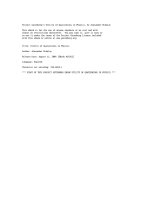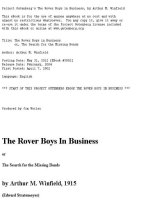Project Gutenberg''''s The Chemistry of Hat Manufacturing, by Watson Smith pptx
Bạn đang xem bản rút gọn của tài liệu. Xem và tải ngay bản đầy đủ của tài liệu tại đây (1.8 MB, 504 trang )
Project Gutenberg's The Chemistry of Hat
Manufacturing, by Watson Smith
This eBook is for the use of anyone
anywhere at no cost and with
almost no restrictions whatsoever. You may
copy it, give it away or
re-use it under the terms of the Project
Gutenberg License included
with this eBook or online at
www.gutenberg.org
Title: The Chemistry of Hat Manufacturing
Lectures Delivered Before the Hat
Manufacturers' Association
Author: Watson Smith
Editor: Albert Shonk
Release Date: February 10, 2006 [EBook
#17740]
Language: English
*** START OF THIS PROJECT GUTENBERG EBOOK
THE CHEMISTRY OF HAT MANUFACTURING ***
Produced by Jason Isbell, Josephine
Paolucci and the Online
Distributed Proofreading Team at
THE
CHEMISTRY
OF
HAT
MANUFACTURING
LECTURES
DELIVERED
BEFORE THE HAT
MANUFACTURERS'
ASSOCIATION
BY
WATSON SMITH,
F.C.S., F.I.C.
THEN LECTURER IN CHEMICAL
TECHNOLOGY IN THE OWENS
COLLEGE, MANCHESTER AND
LECTURER OF THE VICTORIA
UNIVERSITY
REVISED AND
EDITED
BY
ALBERT SHONK
WITH SIXTEEN ILLUSTRATIONS
LONDON
SCOTT, GREENWOOD & SON
"THE HATTERS' GAZETTE" OFFICES
8 BROADWAY, LUDGATE HILL, E.C.
CANADA: THE COPP CLARK CO.
LTD., TORONTO
UNITED STATES: D. VAN NOSTRAND
CO., NEW YORK
1906
[All rights remain with Scott, Greenwood
& Son]
PREFACE
The subject-matter in this little book is the
substance of a series of Lectures
delivered before the Hat Manufacturers'
Association in the years 1887 and 1888.
About this period, owing to the increasing
difficulties of competition with the
products of the German Hat
Manufacturers, a deputation of Hat
Manufacturers in and around Manchester
consulted Sir Henry E. Roscoe, F.R.S.,
then the Professor of Chemistry in the
Owens College, Manchester, and he
advised the formation of an Association,
and the appointment of a Lecturer, who
was to make a practical investigation of
the art of Hat Manufacturing, and then to
deliver a series of lectures on the
applications of science to this industry.
Sir Henry Roscoe recommended the
writer, then the Lecturer on Chemical
Technology in the Owens College, as
lecturer, and he was accordingly
appointed.
The lectures were delivered with copious
experimental illustrations through two
sessions, and during the course a patent by
one of the younger members became due,
which proved to contain the solution of the
chief difficulty of the British felt-hat
manufacturer (see pages 66-68). This
remarkable coincidence served to give
especial stress to the wisdom of the
counsel of Sir Henry Roscoe, whose
response to the appeal of the members of
the deputation of 1887 was at once to
point them to scientific light and training
as their only resource. In a letter recently
received from Sir Henry (1906), he
writes: "I agree with you that this is a
good instance of the direct money value
of scientific training, and in these days of
'protection' and similar subterfuges, it is
not amiss to emphasise the fact."
It is thus gratifying to the writer to think
that the lectures have had some influence
on the remarkable progress which the
British Hat Industry has made in the
twenty years that have elapsed since their
delivery.
These lectures were in part printed and
published in the Hatters' Gazette, and in
part in newspapers of Manchester and
Stockport, and they have here been
compiled and edited, and the necessary
illustrations added, etc., by Mr. Albert
Shonk, to whom I would express my best
thanks.
London, April 1906.
CONTENTS
LECTURE PAGE
I. TEXTILE FIBRES,
PRINCIPALLY WOOL, FUR,
AND HAIR
1
II. TEXTILE FIBRES,
PRINCIPALLY WOOL, FUR,
AND HAIR—continued
18
III. WATER: ITS CHEMISTRY
AND PROPERTIES;
IMPURITIES AND THEIR
ACTION; TESTS OF PURITY
29
IV. WATER: ITS CHEMISTRY
AND PROPERTIES;
IMPURITIES AND THEIR
38
ACTION; TESTS OF PURITY
—continued
V. ACIDS AND ALKALIS
49
VI. BORIC ACID, BORAX,
SOAP
57
VII. SHELLAC, WOOD SPIRIT,
AND THE STIFFENING AND
PROOFING PROCESS
62
VIII. MORDANTS: THEIR
NATURE AND USE
69
IX. DYESTUFFS AND
COLOURS
79
X. DYESTUFFS AND COLORS
—continued
89
XI. DYEING OF WOOL AND
FUR; AND OPTICAL
PROPERTIES OF COLOURS
100
INDEX
117
THE CHEMISTRY
OF HAT
MANUFACTURING
LECTURE I
TEXTILE FIBRES,
PRINCIPALLY WOOL,
FUR, AND HAIR
Vegetable Fibres. —Textile fibres may be
broadly distinguished as vegetable and
animal fibres. It is absolutely necessary,
in order to obtain a useful knowledge of
the peculiarities and properties of animal
fibres generally, or even specially, that
we should be, at least to some extent,
familiar with those of the vegetable fibres.
I shall therefore have, in the first place,
something to tell you of certain principal
vegetable fibres before we commence the
more special study of the animal fibres
most interesting to you as hat
manufacturers, namely, wool, fur, and
hair. What cotton is as a vegetable product
I shall not in detail describe, but I will
refer you to the interesting and complete
work of Dr. Bowman, On the Structure of
the Cotton Fibre. Suffice it to say that in
certain plants and trees the seeds or fruit
are surrounded, in the pods in which they
develop, with a downy substance, and that
the cotton shrub belongs to this class of
plants. A fibre picked out from the mass of
the downy substance referred to, and
examined under the microscope, is found
to be a spirally twisted band; or better,
Fig. 1.
an irregular, more or less flattened and
twisted tube (see Fig. 1). We know it is a
Fig. 2.
tube, because on taking a thin, narrow
slice across a fibre and examining the
slice under the microscope, we can see
the hole or perforation up the centre,
forming the axis of the tube (see Fig. 2).
Mr. H. de Mosenthal, in an extremely
interesting and valuable paper (see
J.S.C.I.,
[1]
1904, vol. xxiii. p. 292), has
recently shown that the cuticle of the
cotton fibre is extremely porous, having,
in addition to pores, what appear to be
minute stomata, the latter being frequently
arranged in oblique rows, as if they led
into oblique lateral channels. A cotton
fibre varies from 2·5 to 6 centimetres in
length, and in breadth from 0·017 to 0·05
millimetre. The characteristics mentioned
make it very easy to distinguish cotton
from other vegetable or animal fibres. For
example, another vegetable fibre is flax,
or linen, and this has a very different
appearance under the microscope (see
Fig. 3). It
Fig. 3.
has a bamboo-like, or jointed appearance;
its tubes are not flattened, nor are they
twisted. Flax belongs to a class called the
bast fibres, a name given to certain fibres
obtained from the inner bark of different
plants. Jute also is a bast fibre. The finer
qualities of it look like flax, but, as we
shall see, it is not chemically identical
with cotton, as linen or flax is. Another
vegetable fibre, termed "cotton-silk," from
its beautiful, lustrous, silky appearance,
has excited some attention, because it
grows freely in the German colony called
the Camaroons, and also on the Gold
Coast. This fibre, under the microscope,
differs entirely in appearance from both
cotton and flax fibres. Its fibres resemble
straight and thin, smooth, transparent,
almost glassy tubes, with large axial
bores; in fact, if wetted in water you can
see the water and air bubbles in the tubes
under the microscope. A more detailed
account of "cotton-silk" appears in a
paper read by me before the Society of
Chemical Industry in 1886 (see J.S.C.I.,
1886, vol. v. p. 642). Now the substance
of the cotton, linen or flax, as well as that
of the cotton-silk fibres, is termed,
chemically, cellulose. Raw cotton consists
of cellulose with about 5 per cent. of
impurities. This cellulose is a chemical
compound of carbon, hydrogen, and
oxygen, and, according to the relative
proportions of these constituents, it has
had the chemical formula C
6
H
10
O
5
assigned to it. Each letter stands for an
atom of each constituent named, and the
numerals tell us the number of the
constituent atoms in the whole compound
atom of cellulose. This cellulose is
closely allied in composition to starch,









